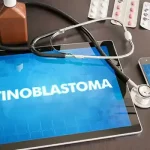Retinoblastoma is a rare form of eye cancer that primarily affects young children. It begins in the retina, which is the light-sensitive tissue at the back of the eye. In this blog post, we will explore the retinoblastoma staging and diagnosis, which are crucial for determining the most appropriate treatment approach.
By understanding the various stages of retinoblastoma and the diagnostic procedures involved, healthcare professionals can develop personalized treatment plans and improve outcomes for patients.
What Is Retinoblastoma?
Retinoblastoma is a malignant tumor that develops in the retina, the part of the eye responsible for detecting light and sending visual information to the brain. It is most commonly found in children under the age of five, although it can occur in older children and adults in rare cases.
The tumor arises from genetic mutations in the cells of the retina, leading to uncontrolled cell growth and the formation of a tumor mass. If left untreated, retinoblastoma can spread to other parts of the eye, including the optic nerve and surrounding tissues.
What Causes Retinoblastoma?
Retinoblastoma is primarily caused by mutations in the RB1 gene, which is responsible for regulating cell division and growth in the retina. These mutations can be inherited from a parent or occur spontaneously during early embryonic development.
In cases where the mutations are inherited, retinoblastoma may develop in both eyes, whereas non-hereditary cases usually affect only one eye. Genetic testing can help determine whether a child has inherited the RB1 gene mutation, which can aid in assessing the risk of developing retinoblastoma.
What Are the Symptoms of Retinoblastoma?
The most common retinoblastoma symptom is the presence of a white pupil, often referred to as “cat’s eye reflex” or “leukocoria.” This is caused by the tumor blocking the normal red reflection of the retina. Other retinoblastoma symptoms may include:
- Crossed or misaligned eyes (strabismus)
- Redness or swelling of the eye
- Poor vision or loss of vision
- Eye pain or irritation
- Changes in the color of the iris
- Bulging/shrinking of the eye
If you notice any of these retinoblastoma symptoms in your child, it is important to consult a healthcare professional for a thorough examination.
Diagnosis of Retinoblastoma
The diagnosis of retinoblastoma typically involves a combination of clinical examination, imaging tests, and genetic testing. A healthcare professional will perform a comprehensive eye examination to assess the size, location, and extent of the tumor.
Imaging tests, such as ultrasound, magnetic resonance imaging (MRI), and computed tomography (CT) scans, may be used to further evaluate the tumor and determine if it has spread to other parts of the eye or beyond. Genetic testing can help identify the presence of RB1 gene mutations. It is essential to diagnose retinoblastoma accurately to guide the most appropriate treatment strategy and ensure the best possible outcome for the patient.
Stages of Retinoblastoma
Retinoblastoma is classified into different stages based on the extent of tumor growth and spread. The retinoblastoma staging system commonly includes:
Intraocular retinoblastoma: The tumor is confined to the eye and has not spread beyond the retina.
Extraocular retinoblastoma: The tumor has spread beyond the eye to nearby structures, such as the optic nerve or tissues surrounding the eye.
Further sub-classifications may be used to describe the specific characteristics of the tumor and guide treatment decisions. The stage of retinoblastoma plays a crucial role in determining the most appropriate treatment approach, whether it involves localized therapies or more extensive interventions.
How to Diagnose Retinoblastoma?
Diagnosing retinoblastoma involves a multidisciplinary approach, including comprehensive eye examination, imaging tests, and genetic testing.
Doctors will carefully evaluate the retinoblastoma symptoms, perform a thorough eye examination, and may use specialized imaging techniques, such as ultrasound, MRI, or CT scans, to visualize the tumor and assess its characteristics.
Genetic testing can help identify the presence of RB1 gene mutations, which provides valuable information regarding the hereditary risk and potential treatment options. Early and accurate diagnosis is critical for initiating timely treatment and improving the chances of successful outcomes.
Retinoblastoma Treatment
The retinoblastoma treatment depends on various factors, including the stage of the tumor, the presence of RB1 gene mutations, and the overall health of the patient. Treatment options may include:
Localized therapies: These aim to target the tumor within the eye and may include laser therapy, cryotherapy (freezing the tumor), thermotherapy (application of heat), or plaque brachytherapy (placement of a radioactive device).
Systemic chemotherapy: This involves the use of medications that circulate throughout the body to destroy cancer cells. Chemotherapy may be administered orally, intravenously, or directly into the eye.
Radiation therapy: In some cases, external beam radiation therapy or brachytherapy may be used to deliver targeted radiation to the tumor.
Enucleation: This surgical procedure involves the removal of the affected eye. It may be necessary in cases where the tumor is extensive or unresponsive to other treatments.
The choice of retinoblastoma treatment will be tailored to each individual case, with the goal of preserving vision whenever possible while ensuring the eradication of the tumor.
Conclusion
Staging and diagnosing retinoblastoma are crucial steps in the management of this rare eye cancer. By accurately determining the stage of the tumor and identifying specific genetic mutations, healthcare professionals can develop personalized treatment plans to maximize the chances of a successful outcome.
Early detection and prompt treatment are essential for preserving vision and improving the long-term prognosis for children with retinoblastoma. If you suspect any signs or symptoms of retinoblastoma in your child, it is important to seek medical attention immediately.
Know about the Facts of Eye Cancer here .
FAQs
What is retinoblastoma?
Retinoblastoma is a rare form of eye cancer that primarily affects young children. It originates in the retina and can lead to vision loss or other complications if left untreated.
What are the different stages of retinoblastoma?
Retinoblastoma is classified into intraocular retinoblastoma (confined to the eye) and extraocular retinoblastoma (spread beyond the eye to nearby structures). Further sub-classifications may be used to describe specific tumor characteristics.
How is retinoblastoma diagnosed?
The diagnosis of retinoblastoma involves a comprehensive eye examination, imaging tests (ultrasound, MRI, CT scans), and genetic testing to identify RB1 gene mutations.
What tests are used to stage retinoblastoma?
Retinoblastoma staging may involve clinical examination, imaging tests (ultrasound, MRI, CT scans), and assessment of tumor characteristics through genetic testing.
What should I ask my doctor about my child’s retinoblastoma diagnosis?
Some questions to ask your doctor about your child’s retinoblastoma diagnosis include: What are the treatment options? What are the potential side effects? What is the long-term prognosis? How can we support our child during treatment?





